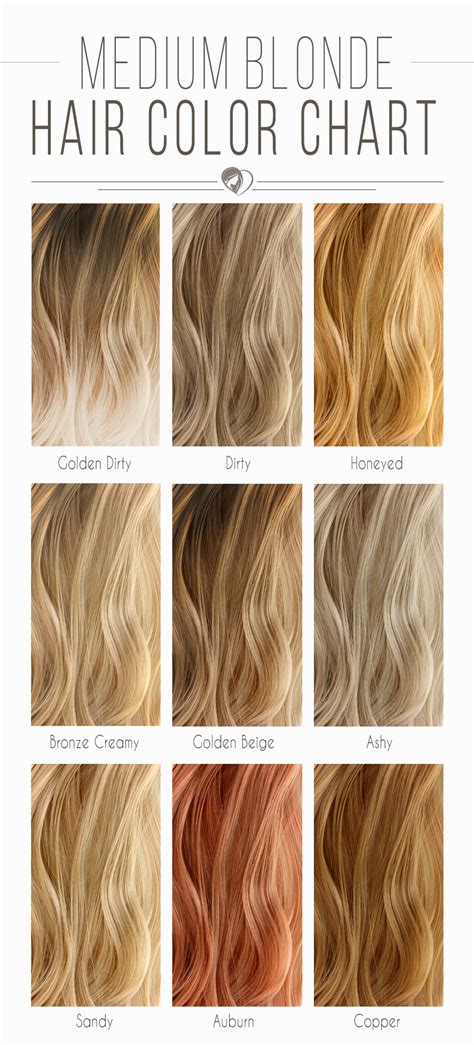Blondes have more fun, or so the saying goes. And with so many shades of blonde to choose from, there’s a blonde hair color out there to suit everyone.

But with so many different shades of blonde, it can be hard to know where to start. That’s why we’ve put together this comprehensive blonde color chart.
In this chart, you’ll find everything you need to know about the 100+ shades of blonde, from the lightest platinum to the darkest honey. We’ll also provide you with tips on how to choose the right shade of blonde for your skin tone and hair type.
Blonde hair is classified into three main categories:
- Light blonde: This category includes the lightest shades of blonde, such as platinum, white blonde, and ash blonde.
- Medium blonde: This category includes the middle shades of blonde, such as golden blonde, honey blonde, and strawberry blonde.
- Dark blonde: This category includes the darkest shades of blonde, such as caramel blonde, toffee blonde, and chocolate blonde.
Within each of these categories, there are dozens of different shades of blonde. The exact shade of blonde that you choose will depend on your skin tone, hair type, and personal preferences.
When choosing a shade of blonde, there are a few things to keep in mind:
- Your skin tone: Fair-skinned people can wear lighter shades of blonde, while darker-skinned people can wear darker shades of blonde.
- Your hair type: Fine hair can hold lighter shades of blonde better than thick hair. Thick hair can hold darker shades of blonde better than fine hair.
- Your personal preferences: Ultimately, the best shade of blonde for you is the one that you love.
The following table provides a comprehensive list of the 100+ shades of blonde, from the lightest platinum to the darkest honey.
| Shade | Description |
|---|---|
| Platinum | The lightest shade of blonde, platinum is almost white. |
| White blonde | A very light shade of blonde, white blonde is slightly darker than platinum. |
| Ash blonde | A cool-toned shade of blonde, ash blonde has a slightly gray tint. |
| Golden blonde | A warm-toned shade of blonde, golden blonde has a golden hue. |
| Honey blonde | A medium shade of blonde, honey blonde has a golden-brown hue. |
| Strawberry blonde | A light shade of blonde with a reddish tint, strawberry blonde is a popular choice for fair-skinned people. |
| Caramel blonde | A medium shade of blonde with a golden-brown hue, caramel blonde is a popular choice for darker-skinned people. |
| Toffee blonde | A dark shade of blonde with a golden-brown hue, toffee blonde is a popular choice for people with thick hair. |
| Chocolate blonde | The darkest shade of blonde, chocolate blonde has a deep brown hue. |
| Level | Description |
|---|---|
| 1 | Black |
| 2 | Very dark brown |
| 3 | Dark brown |
| 4 | Medium brown |
| 5 | Light brown |
| 6 | Dark blonde |
| 7 | Medium blonde |
| 8 | Light blonde |
| 9 | Very light blonde |
| 10 | Platinum |
There are both pros and cons to dyeing your hair blonde.
Pros:
- Blonde hair can make you look younger and more vibrant.
- Blonde hair can help to brighten up your complexion.
- Blonde hair can be styled in a variety of ways.
Cons:
- Blonde hair can be damaging to your hair.
- Blonde hair can be expensive to maintain.
- Blonde hair can be difficult to keep looking fresh.
If you’re thinking about dyeing your hair blonde, there are a few things you can do to help maintain your new hair color:
- Use a color-safe shampoo and conditioner.
- Avoid using hot tools on your hair.
- Get regular trims to remove split ends.
- Use a deep conditioner once a week to help repair your hair.
Blonde hair is a beautiful and versatile hair color that can be worn by people of all ages and skin tones. If you’re thinking about dyeing your hair blonde, be sure to do your research and choose a shade that complements your skin tone and hair type. With proper care and maintenance, you can keep your blonde hair looking beautiful and healthy for years to come.
In addition to the information provided in this article, here are some additional resources that you may find helpful:
- American Hairdressers Association
- National Hairdressers Association
- International Hairdressers Association
